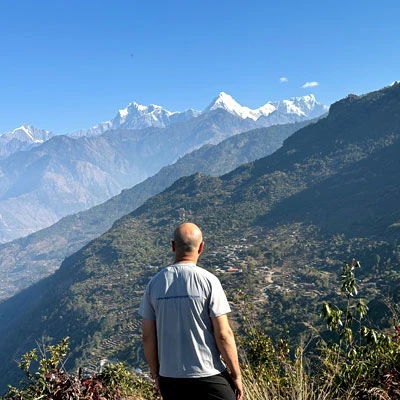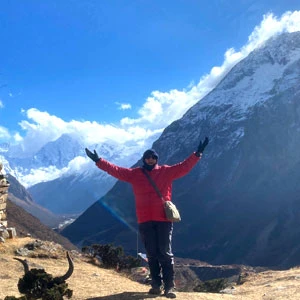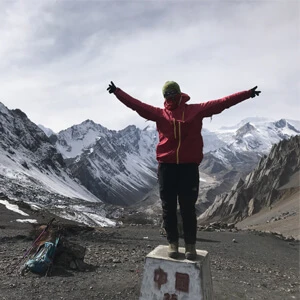Overview Of The Manaslu Tsum Valley Trek
The Manaslu Tsum Valley Trek leads you through one of Nepal’s most remote and culturally sacred regions, tucked into the northern Gorkha District near the Tibetan border. This trail combines the raw alpine beauty of the Manaslu Circuit with the spiritual richness of the hidden Tsum Valley.
What sets this journey apart is its rare blend of terrain and culture. The Tsum Valley, once restricted to foreigners, preserves authentic Tibetan Buddhist traditions, ancient monasteries, and secluded villages that remain untouched by mainstream tourism. As the trail continues, it merges with the rugged, high-altitude loop of the Manaslu Circuit, where the landscape becomes more dramatic and physically demanding.
Since this trek passes through a restricted area, you must travel with a government-registered trekking agency, obtain secure special permits, and travel with a registered local guide. While basic tea house accommodation is available in more developed villages, many remote sections, especially within the Tsum Valley, still require camping support due to limited infrastructure. As a result, you will need thoughtful planning when it comes to choosing the right accommodation on the Manaslu Tsum Valley Trek.
What Are Tea Houses On The Manaslu Tsum Valley Trek?
Tea houses are the heart and soul of trekking in Nepal, especially on routes like the Manaslu Tsum Valley Trek. These locally operated guesthouses offer authentic cultural encounters, warm meals, and a place to rest after a long day on the trail. Along the Manaslu Tsum route, tea house accommodations are typically small, family-run lodges constructed from stone and timber.
Most tea house accommodations in the Manaslu Tsum Valley provide basic but functional facilities. You will usually get a private twin room with two single beds, foam mattresses, pillows, and thick blankets. You should also bring your own sleeping bag for added comfort. Here, central dining areas feature wood-burning stoves where you can gather for warmth and enjoy home-cooked meals.
Bathrooms are shared and range from simple squat toilets to basic Western-style toilets, depending on the village. Additionally, showers may be cold or lukewarm, and hot water is often available for an extra fee. As you move into more remote sections of the Tsum Valley, facilities become increasingly basic.
Altogether, choosing tea house accommodation on the Manaslu Tsum Valley Trek allows you to travel light, reduce logistical challenges, and fully engage with the rich traditions of the region.
What Is Camping Trekking In Manaslu Region?
Camping trekking on remote trails like the Manaslu Tsum Valley Trek offers the classic Himalayan adventure. This style of accommodation is ideal if you are seeking solitude, flexibility, and deep immersion in nature.
During a camping trek in Manaslu, you carry everything needed to survive in the wild, such as tents, food supplies, cooking equipment, and essential gear, which is all managed by a dedicated support team. Your crew includes experienced guides, cooks, and porters who ensure a smooth and safe journey from start to finish.
Each day, the team sets up and dismantles camp, pitching tents in stunning alpine locations. Cooks prepare fresh, hot meals on portable stoves, while porters handle the logistics and transport of gear. Here, you will sleep in sturdy trekking tents and dine in communal tents under the Himalayan sky.
Organizing a camping-based trek in the Manaslu Tsum valley region requires advance permits, careful planning, and additional resources. While camping accommodation on the Manaslu Tsum Valley Trek is more demanding and resource-intensive, it rewards you with unmatched freedom, access to off-the-grid trails, and the chance to experience nature in its rawest form.
Tea House Accommodation On The Manaslu Tsum Valley Trek
Along the routes of Manaslu Tsum Valley, tea houses are simple, family-run lodges offering basic rooms, hearty meals, and warm hospitality. Here, the comfort is modest and amenities are limited.
Pros Of Tea House Trekking In Manaslu Tsum Valley
- Experience traditional Himalayan hospitality by staying in local tea houses run by mountain families across the Manaslu and Tsum Valley region.
- Save significantly on overall trekking costs, as tea house accommodation in Tsum Valley is much more affordable than organizing a full camping trek.
- Opportunity to connect with fellow trekkers from around the world in shared dining areas and communal lodges.
- Sleep indoors with better protection from wind, snow, and cold temperatures, especially at higher elevations along the Manaslu Circuit.
- Adapt your trekking itinerary easily, without the need to coordinate camping logistics or scout for tent-pitching locations each day.
- Minimize environmental impact, as tea houses reduce the need to transport heavy gear, fuel, and waste into fragile ecosystems.
Cons Of Tea House Trekking In Manaslu Tsum Valley
- Struggle to find tea houses in the less-traveled areas of the upper Tsum Valley, where remote villages offer limited or no lodging options.
- Have to sleep in rooms with thin plywood walls, basic beds, and no insulation, with minimal comfort in harsh mountain conditions.
- Hard to find accommodation in peak trekking seasons like Autumn, especially at popular overnight stops along the Manaslu Circuit and Tsum Valley.
- Deal with unreliable electricity, non-functioning charging ports, and the absence of Wi-Fi in many tea houses, particularly in high-altitude villages.
- Most tea house bedrooms may lack any form of heating system, even at higher elevations.
Camping On The Manaslu Tsum Valley Trek
Camping trek on the routes of Manaslu Tsum Valley offers you the freedom to venture beyond tea house routes and sleep under the stars in complete wilderness. You will get to experience the trail in its rawest, most secluded form, far from the crowds and deep in nature.
Pros Of Camping On Manaslu Tsum Valley Trek
- Choose your campsite freely based on weather conditions, scenic beauty, or your preferred trekking distance each day.
- Access off-the-beaten-path sections such as Mu Gompa, Ripchet, and the remote high trails of upper Tsum Valley, where tea houses are scarce or non-existent.
- Enjoy freshly prepared meals by your trekking crew, customized to your dietary needs.
- Experience peaceful, starlit nights in serene locations far from busy lodges.
- Avoid the stress of overcrowded tea houses during peak trekking seasons like Autumn and Spring.
Cons Of Camping On Manaslu Tsum Valley Trek
- Pay significantly more for a full support team, including experienced guides, porters, cooks, and the rental or transport of essential camping gear.
- May miss valuable cultural interactions with locals, since camping often places you outside village settlements where community engagement is limited.
- Struggle with weather challenges, such as rain, snow, or high winds, which can make sleeping in tents uncomfortable.
- Face limited emergency support, as camping away from villages reduces immediate access to help in case of illness, injury, or unexpected route changes.
- You will have to manage more permits and logistics, particularly in restricted zones like Tsum Valley.
Cost Comparision: Tea House Vs. Camping Trek On Manaslu Tsum Valley Trek
When it comes to accommodation on the Manaslu Tsum Valley Trek, your choice between tea house trekking and camping significantly impacts your overall budget. Each option offers a different price point, level of comfort, and logistical demand.
Tea house trekking is typically the more budget-friendly accommodation style. On average, you will spend around USD 35 to 50 per day. This daily cost usually covers basic lodging in local tea houses, three meals, limited device charging, and occasional access to hot showers. Over the course of a standard 18 to 21-day Manaslu Tsum Valley trek, the total accommodation and food cost ranges from approximately USD 700 to 1,000 per person, excluding permit fees and the cost of hiring guides or porters.
In contrast, camping accommodation in the Manaslu region trek demands a larger investment due to the need for a full support team, including guides, porters, cooks, tents, and cooking equipment. Daily expenses typically fall between USD 90 and 120, making the total cost for the same duration around USD 1,800 to 2,500 per person, depending on group size, gear quality, and route logistics.
That said, larger groups can reduce the per-person cost of a camping trek through shared resources and bulk food supplies. Hence, it can be more cost-effective option for team expeditions or guided groups seeking flexibility and remote access.
Below is a brief cost breakdown on your daily cost.
Category | Tea House Trek (USD per day) | Camping Trek (USD per day) |
Accommodation | 5 to 10 | Included in crew cost |
Meals (3 times a day) | 20 to 25 | Included in food supplies |
Extra Charge (charging, hot showers) | 2 to 5 | N/A |
Guide | 25 to 30 (shared) | 25 to 30 (shared) |
Porter | 20 to 25 (optional) | 20 to 25 (mandatory) |
Cook & Assistant Staff | N/A | 15 to 25 |
Cooking Equipments | N/A | 10 to 20 |
Food Supplies | N/A | 15 to 20 |
Permits | 135 to 160 | 135 to 160 (may have additional cost) |
Total Estimated Daily Cost | 35 to 50 | 90 to 120 |
Which Trekking Style Is Best For Manaslu Tsum Valley Route?
Both the tea house and camping trek on the Manaslu Tsum Valley offers a different flavor of adventure, and the right choice depends on your priorities, preferences, and trekking style.
Choose Tea House Trekking If,
You enjoy traveling light, connecting with locals, and soaking in authentic village life along the trail. Tea house trekking in Manaslu Tsum Valley provide a balance of comfort and cultural immersion, which is ideal if you are trekking in small groups.
Tea house accommodation in Manaslu Tsum Valley trek have simple rooms, which are cozy and serves warm meals by a fire. Likewise, if you are budget-conscious and want a semi-structured yet spontaneous journey, tea houses are the way to go.
Choose Camping Trekking If,
You crave solitude and want to explore remote, off-the-grid sections of the trek, especially in upper Tsum Valley or during the off-season when tea houses may be closed. Camping treks in Manaslu Tsum Valley are perfect for larger groups. You will get to enjoy full control over your pace, meals, and overnight stops.
Hybrid Accommodation Option: Combining Tea Houses And Camping On Manaslu Tsum Valley Trek
If you want to enjoy both comfort and adventure, a hybrid trekking accommodation style offers the best of both worlds on the Manaslu Tsum Valley Trek. This flexible approach allows you to stay in tea houses whenever available, while switching to camping in more remote stretches where accommodation is limited or non-existent.
By planning a hybrid accommodation strategy, you will gain the freedom to enjoy local hospitality, home-cooked meals, and lighter logistics in developed villages, without having to commit to carrying full camping gear for the entire route. You can pack only minimal camping essentials, which helps reduce your environmental footprint, lighten your load, and cut down overall costs.
For example, most of the Manaslu Circuit offers functional tea house accommodation, especially in places like Lho, Samagaun, and Namrung. However, in the upper Tsum Valley, camping becomes essential in isolated stretches, particularly between Nile and Mu Gompa or near Lungdang Gumba.
With a hybrid trekking option for accommodation on the Manaslu Tsum Valley Trek, you will find balanced convenience, cost, and adventure.
Tips For A Comfortable Manaslu Tsum Valley Trek
For Tea House Trekkers
- Carry a headlamp as power outages are common.
- Have a power bank and extra batteries.
- Bring flip-flops or sandals for comfort inside the tea house in the evenings.
- Pack earplugs as thin walls and early risers can interrupt your sleep.
- Carry some cash for small purchases like hot showers and Wi-Fi.
- Expect simple menus and don’t rely on variety.
For Campers
- Hire an experienced crew including a knowledgeable guide, cook, and porters.
- Use eco-friendly gear, reusable cutlery, biodegradable soap, and trash bags.
- Invest in a quality tent and sleeping pad.
- Plan your food supplies wisely.
- Have backup batteries or solar chargers for lighting and navigation tools.
- Choose safe campsites away from rivers and unstable slopes, and follow Leave No Trace principles.
Conclusion
Choosing between tea houses and camping accommodation on the Manaslu Tsum Valley Trek ultimately comes down to your travel style, budget, and appetite for adventure. Tea house accommodations offer simplicity, local interaction, and a lighter setup while camping accommodation provides unmatched freedom, access to remote and mystical corners. Both have their own pros and cons, and neither is universally better.
If you are unsure, consider blending both styles or reaching out to professionals who know the trail inside out. Agencies like Nepal Trekking Experts can help tailor the perfect itinerary based on your preferences.
FAQs
What is the main difference between tea houses and camping on the Manaslu Tsum Valley Trek?
Tea houses offer pre-arranged lodging, meals, and a social atmosphere, while camping requires bringing your own gear, setting up tents, and arranging a support team for cooking and logistics.
Is camping more expensive than staying in tea houses in Tsum Valley?
Yes, camping tends to be more expensive due to the need for permits, porters, cooks, and additional camping gear.
Can I do a hybrid accommodation for Manaslu Tsum Valley Trek with both tea houses and camping?
Absolutely! You can use tea houses where available and camp in remote areas like Mu Gompa or upper Tsum.
Do I need to carry a sleeping bag for a tea house trek in Manaslu Tsum Valley?
Yes, NTE highly recommends you to bring a sleeping bag, especially for higher altitudes.
Do I need permits for both tea house and camping treks in Manaslu Tsum Valley?
Yes, you will need the Manaslu Conservation Area Permit (MCAP) and the Tsum Valley Restricted Area Permit for both options, with additional permits required for camping treks.
Can I expect Wi-Fi or charging options in tea houses?
While some tea houses offer Wi-Fi and charging services, but the availability is limited and may come at an additional cost.







